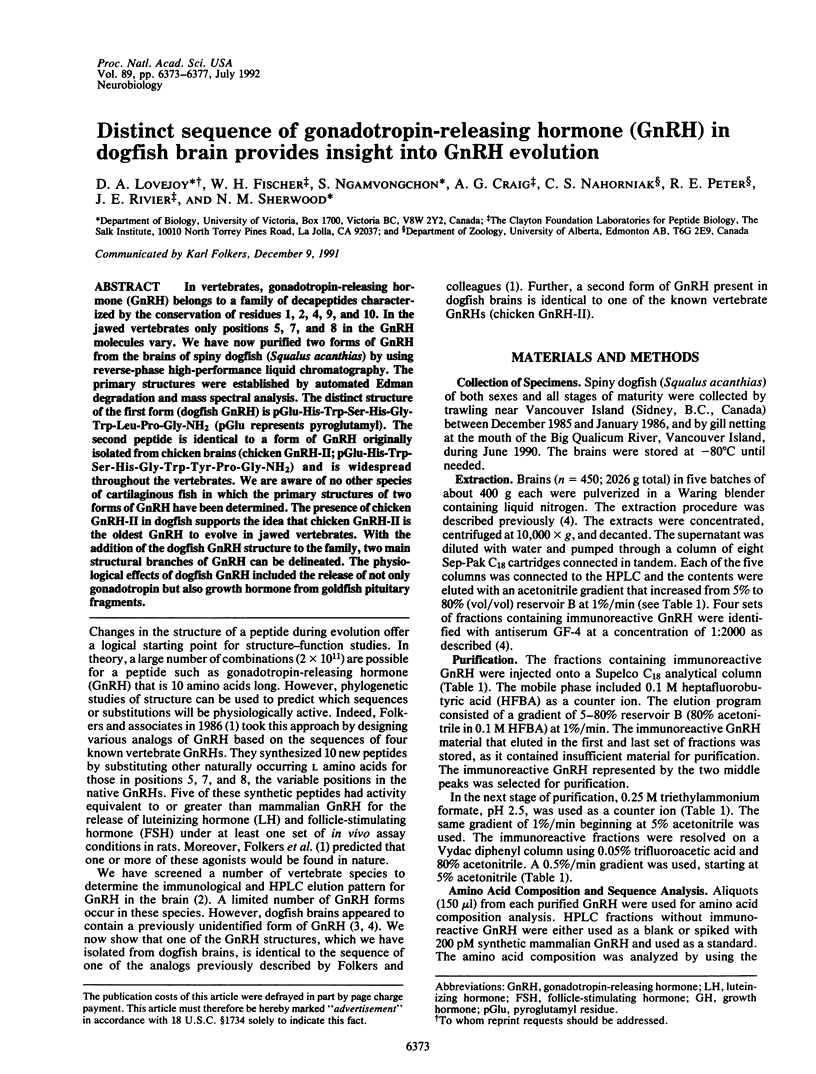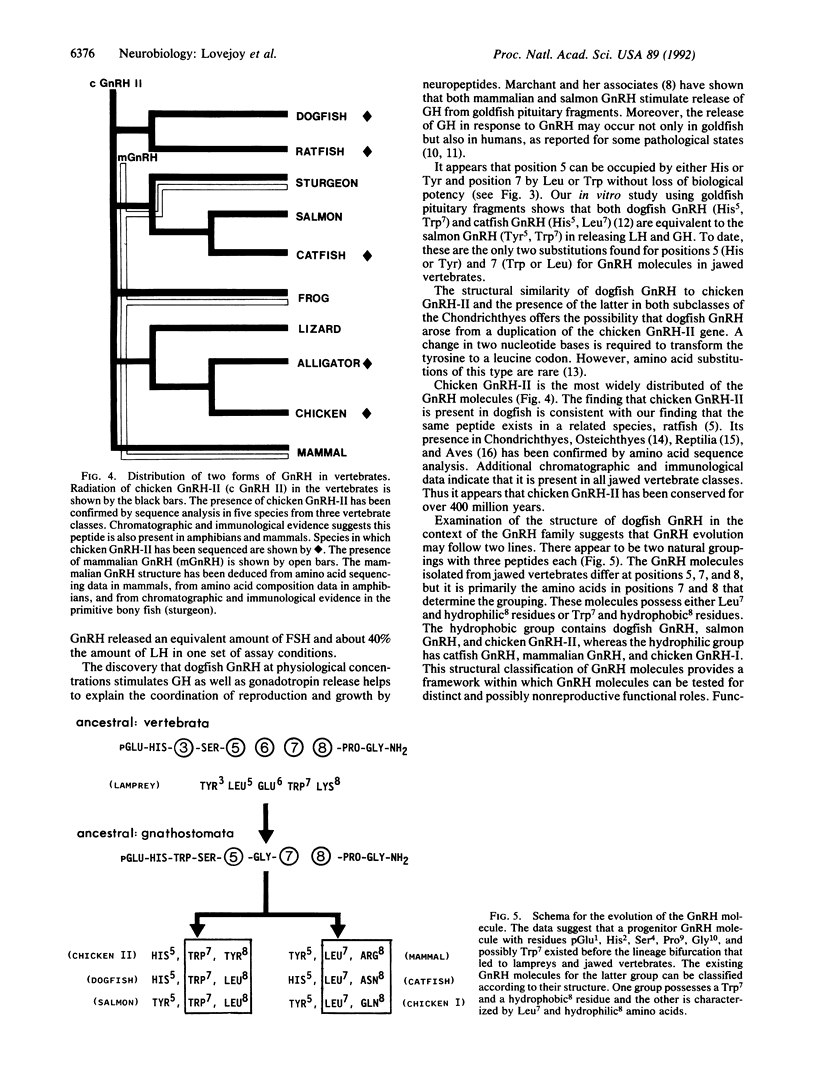Abstract
In vertebrates, gonadotropin-releasing hormone (GnRH) belongs to a family of decapeptides characterized by the conservation of residues 1, 2, 4, 9, and 10. In the jawed vertebrates only positions 5, 7, and 8 in the GnRH molecules vary. We have now purified two forms of GnRH from the brains of spiny dogfish (Squalus acanthias) by using reverse-phase high-performance liquid chromatography. The primary structures were established by automated Edman degradation and mass spectral analysis. The distinct structure of the first form (dogfish GnRH) is pGlu-His-Trp-Ser-His-Gly-Trp-Leu-Pro-Gly-NH2 (pGlu represents pyroglutamyl). The second peptide is identical to a form of GnRH originally isolated from chicken brains (chicken GnRH-II; pGlu-His-Trp-Ser-His-Gly-Trp-Tyr- Pro-Gly-NH2) and is widespread throughout the vertebrates. We are aware of no other species of cartilaginous fish in which the primary structures of two forms of GnRH have been determined. The presence of chicken GnRH-II in dogfish supports the idea that chicken GnRH-II is the oldest GnRH to evolve in jawed vertebrates. With the addition of the dogfish GnRH structure to the family, two main structural branches of GnRH can be delineated. The physiological effects of dogfish GnRH included the release of not only gonadotropin but also growth hormone from goldfish pituitary fragments.
Full text
PDF




Selected References
These references are in PubMed. This may not be the complete list of references from this article.
- Cantalamessa L., Catania A., Silva A., Orsatti A., Motta P., Cazzullo C. L. Gonadotropin releasing hormone elicits abnormal hormone responses in schizophrenia. Psychoneuroendocrinology. 1985;10(4):481–484. doi: 10.1016/0306-4530(85)90088-5. [DOI] [PubMed] [Google Scholar]
- Folkers K., Bowers C. Y., Tang P. F., Kubota M. Decapeptides as effective agonists from L-amino acids biologically equivalent to the luteinizing hormone-releasing hormone. Proc Natl Acad Sci U S A. 1986 Feb;83(4):1070–1074. doi: 10.1073/pnas.83.4.1070. [DOI] [PMC free article] [PubMed] [Google Scholar]
- Lovejoy D. A., Fischer W. H., Parker D. B., McRory J. E., Park M., Lance V., Swanson P., Rivier J. E., Sherwood N. M. Primary structure of two forms of gonadotropin-releasing hormone from brains of the American alligator (Alligator mississippiensis). Regul Pept. 1991 Apr 25;33(2):105–116. doi: 10.1016/0167-0115(91)90206-v. [DOI] [PubMed] [Google Scholar]
- Lovejoy D. A., Sherwood N. M., Fischer W. H., Jackson B. C., Rivier J. E., Lee T. Primary structure of gonadotropin-releasing hormone from the brain of a holocephalan (ratfish: Hydrolagus colliei). Gen Comp Endocrinol. 1991 Apr;82(1):152–161. doi: 10.1016/0016-6480(91)90306-q. [DOI] [PubMed] [Google Scholar]
- Lovejoy D. A., Stell W. K., Sherwood N. M. Partial characterization of four forms of immunoreactive gonadotropin-releasing hormone in the brain and terminal nerve of the spiny dogfish (Elasmobranchii; Squalus acanthias). Regul Pept. 1992 Jan 2;37(1):39–48. doi: 10.1016/0167-0115(92)90062-y. [DOI] [PubMed] [Google Scholar]
- Marchant T. A., Chang J. P., Nahorniak C. S., Peter R. E. Evidence that gonadotropin-releasing hormone also functions as a growth hormone-releasing factor in the goldfish. Endocrinology. 1989 May;124(5):2509–2518. doi: 10.1210/endo-124-5-2509. [DOI] [PubMed] [Google Scholar]
- Miyamoto K., Hasegawa Y., Nomura M., Igarashi M., Kangawa K., Matsuo H. Identification of the second gonadotropin-releasing hormone in chicken hypothalamus: evidence that gonadotropin secretion is probably controlled by two distinct gonadotropin-releasing hormones in avian species. Proc Natl Acad Sci U S A. 1984 Jun;81(12):3874–3878. doi: 10.1073/pnas.81.12.3874. [DOI] [PMC free article] [PubMed] [Google Scholar]
- Peter R. E., Nahorniak C. S., Chang J. P., Crim L. W. Gonadotropin release from the pars distalis of goldfish, Carassius auratus, transplanted beside the brain or into the brain ventricles: additional evidence for gonadotropin-release-inhibitory factor. Gen Comp Endocrinol. 1984 Sep;55(3):337–346. doi: 10.1016/0016-6480(84)90001-7. [DOI] [PubMed] [Google Scholar]
- Rivier J., McClintock R., Galyean R., Anderson H. Reversed-phase high-performance liquid chromatography: preparative purification of synthetic peptides. J Chromatogr. 1984 Apr 24;288(2):303–328. doi: 10.1016/s0021-9673(01)93709-4. [DOI] [PubMed] [Google Scholar]
- Rubin A. L., Levin S. R., Bernstein R. I., Tyrrell J. B., Noacco C., Forsham P. H. Stimulation of growth hormone by luteinizing hormone-releasing hormone in active acromegaly. J Clin Endocrinol Metab. 1973 Jul;37(1):160–162. doi: 10.1210/jcem-37-1-160. [DOI] [PubMed] [Google Scholar]
- Sherwood N. M., Sower S. A. A new family member for gonadotropin-releasing hormone. Neuropeptides. 1985 Jun;6(3):205–214. doi: 10.1016/0143-4179(85)90091-5. [DOI] [PubMed] [Google Scholar]
- Sherwood N., Eiden L., Brownstein M., Spiess J., Rivier J., Vale W. Characterization of a teleost gonadotropin-releasing hormone. Proc Natl Acad Sci U S A. 1983 May;80(9):2794–2798. doi: 10.1073/pnas.80.9.2794. [DOI] [PMC free article] [PubMed] [Google Scholar]


